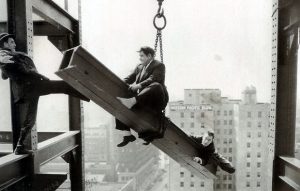 The early church had the same problems many of today’s fledgling organizations have: more poets than planners. As Christ’s 12 disciples started spreading their Master’s timeless words, they couldn’t keep up with the temporal works of infrastructure development needed to support their mission. That included maintenance of the members who would give each other shelter and protection. In architectural terms, if Jesus Christ was the cornerstone—the first stone set in this structure—then all members who would follow would have to be carefully organized in reference to this stone to ensure the integrity of the entire church. Jesus had already established Peter as the rock upon which his church would be built, so as Sunday’s readings tell us, this church was ready to rise with Christ’s resurrection—as long as its builders could caulk any cracks that threatened this organization’s integrity. This Sunday’s first reading from Acts (Acts 6:1-7) explains:
The early church had the same problems many of today’s fledgling organizations have: more poets than planners. As Christ’s 12 disciples started spreading their Master’s timeless words, they couldn’t keep up with the temporal works of infrastructure development needed to support their mission. That included maintenance of the members who would give each other shelter and protection. In architectural terms, if Jesus Christ was the cornerstone—the first stone set in this structure—then all members who would follow would have to be carefully organized in reference to this stone to ensure the integrity of the entire church. Jesus had already established Peter as the rock upon which his church would be built, so as Sunday’s readings tell us, this church was ready to rise with Christ’s resurrection—as long as its builders could caulk any cracks that threatened this organization’s integrity. This Sunday’s first reading from Acts (Acts 6:1-7) explains:
The Hellenists complained against the Hebrews because their widows were being neglected in the daily distribution. So the Twelve called together the community of the disciples and said, “It is not right for us to neglect the word of God to serve at table. Brothers, select from among you seven reputable men, filled with the Spirit and wisdom, whom we shall appoint to this task, whereas we shall devote ourselves to prayer and to the ministry of the word.”
The mortar of this church has always been faith as supplied through the Holy Spirit, but as those early cracks proved, maintenance was a continuous necessity. As Peter the rock explains in our second reading (1 Pt 2:4-9), the real work lay in mutual sacrifice.
Come to him, a living stone, rejected by human beings but chosen and precious in the sight of God, and, like living stones, let yourselves be built into a spiritual house to be a holy priesthood to offer spiritual sacrifices.
But as we said at the start, the poetry of Christ’s words had to be supported by an infrastructure that kept those words flowing. Those early builders had to be steeped in the faith to ensure future generations would apply their skills properly in relation to the cornerstone so other workers wouldn’t fall from their faith—which, unfortunately became an occupational hazard in our church’s development. As Peter said of the cornerstone others rejected:
[it] will make people stumble, and … will make them fall. They stumble by disobeying the word, as is their destiny.
With all those casualties, it’s amazing the church Christ designed still stands after two millennia. As Sunday’s gospel reading from John implies, those 12 original builders had a hard time understanding their Master’s plans (Jn 14:1-12).
Thomas said to him, “Master, we do not know where you are going; how can we know the way?”
Then Jesus explained how a cornerstone works with all of the other stones built around it—but he used poetry as his tool to stir their spirit:
“I am the way and the truth and the life. No one comes to the Father except through me. If you know me, then you will also know my Father. … whoever believes in me will do the works that I do, and will do greater ones than these, because I am going to the Father.”
Our 21st century faith is strengthened by the same spirit which is now showing us how to build the bridge connecting our church to our Father. Imagine that—an infrastructure project with an unknown timeline but a guaranteed payback. Now that’s a miracle.
–Tom Andel